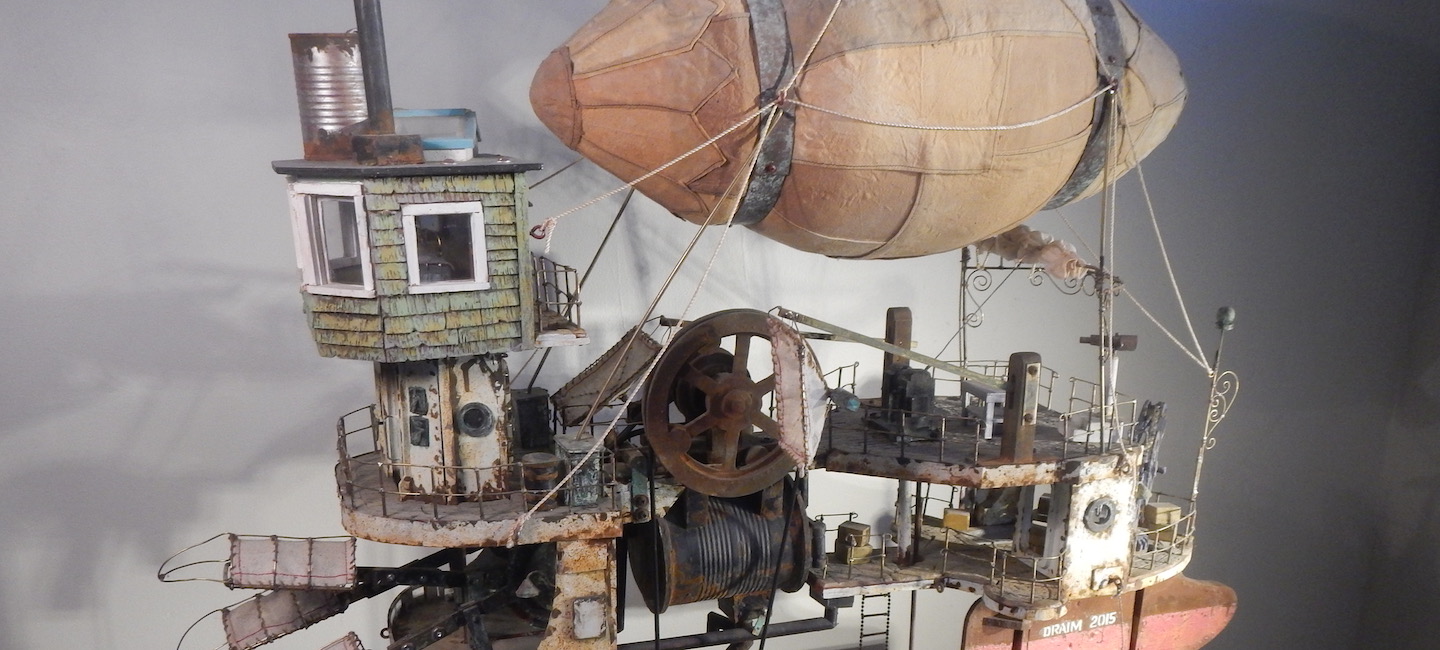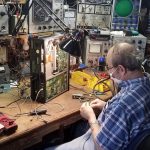A rustbelt steampunk artist brings his creation to a city that mirrors just that. Open the door and journey into Ken Draim’s world, where it echoes his childhood impression of Paris come to life, with the layered formation of rusted metal and stone, aged wood, and other textural elements to birth the feel of history. Draim is a distinguished automata and kinetic sculpture artist who moved to Pittsburgh’s South Side three years ago from Taos, New Mexico, which was his home for almost 40 years after earning his BFA in painting at Washington University in St. Louis.
Draim’s world of the mischievous carnival transcends us to the bygone era and his sculptures exude a sense of amazement, sound and movement while capturing the wondrous vision of steam-engine technology, combining 19th-century machine aesthetics with creative expression and engineering. If you throw into the pot Jules Verne’s novels, Wes Anderson films, Andy Warhol’s fashion illustrations, and Alex Calder’s “Circus” sculptures, the result is Ken Draim’s storybook that delights us to glee.
We asked Ken Draim a few questions about his final voyage to Pittsburgh to call it home and how he navigates the city as a mid-career artist.
Question: What brought you to Pittsburgh?
Ken: My wife and I moved to Pittsburgh three years ago from Taos, N.M. We had a small art gallery in Taos, where I sold my automatons. Taos is a well established art community, focusing more on traditional Southwestern art. We were looking for a change and more opportunities. We searched all over the country before settling on Pittsburgh. We were drawn to Pittsburgh, although we had never visited before, because of its affordability, walkability, and character.
Q: What do you think this city has to offer in terms of art?
K: Being an automaton artist, the industrial heritage of Pittsburgh that permeates the city is a great inspiration for my work. The old brick row houses, bridges, and factories are an endless wellspring of inspiration. It is a city of potential – a city re-invented, not yet defined, and not fully realized. I see that as a great strength.
Q: What needs to happen to bring more visibility in the arts and attract artists to Pittsburgh?
K: I think the city has made strides to encourage the art scene. Pre-Covid, I was involved with many local organizations that unite and promote artists and was scheduled to display my work in a number of exhibitions, markets and galleries. Of course, much more could be done to liven things up. Why not take advantage of all those beautiful old factory buildings, and create a space where many artists can create and exhibit? This could be done along the lines of the Torpedo Factory in Alexandria, VA and have sliding scales for rent, to entice the more struggling artists. Art Centers can be popular attractions for visitors to the city.
Q: Pittsburgh has a strong industrial, manufacturing and engineering heritage. How does machine technology inspire or affect your work?
K: Although Pittsburgh is now known for its cutting edge engineering and robotics, I draw my influence from the ghosts of the machine technology of the industrial revolution that is still felt throughout the city. I do feel like modern engineering technology can draw inspiration from the past. I was exhibiting my automatons on Market Square, when a professor from Carnegie Mellon happened to walk by and saw my machines. She asked me to consult with her students who were building automatons. It is so important for the students to see the bridge between art and science. Both disciplines benefit when they work together.
Q: What do you like about living in Pittsburgh and what would you like to see change?
K: Overall, my wife and I enjoy living here. It’s a mid-sized city with plenty of green spaces and a lot of cultural things to do. It’s a dynamic city on the cusp of becoming something great. In addition to brick and mortar galleries, and art festivals, local businesses could have catered art openings and art talks, and feature exhibits from a local artists “clearinghouse”. That would get exposure for new artists and integrate the arts into the community. I have found that many Pittsburghers are interested in the arts, just underexposed.
Q: What is one simple advice you would give to young artists thinking about moving to Pittsburgh?
K: The one piece of advice or encouragement I could give a young artist thinking of moving to Pittsburgh is that you have the potential of creating your own art scene here, and don’t have to fit into established rigid molds. This city is in the midst of a new beginning and anything is possible. Use your imagination.


